Summers down at the jersey shore are, as anyone who has been there knows, nothing short of crazy. This craziness involves people from all over the place heading into the ocean to swim, boat, dive, snorkel, etc. What can you find when you head into the water? Many people believe that there are no sharks in New Jersey. Well, I am here to tell you all that New Jersey is actually a shark haven during the summer months, but you would never know that these animals even visit New Jersey if you were to enter the ocean on any given day. So without further delay, let us once again meet some of the sharks that can be seen in New Jersey. Note that not all of these sharks are common to our waters, but have been known to make an appearance.
Sandbar Shark

One of the more common species of shark to visit New Jersey during the late spring/summer months. Despite growing to be over 5 feet in length and weighing on average 150lbs, the sandbar shark is a very skittish species of shark. They are very strong swimmers and as their name suggests, tend to been seen in shallow waters. Their primary diet consists of small fish and squids. They are currently listed as "Vulnerable" on the IUCN's Red List due to finning and overfishing.
Smooth Dogfish
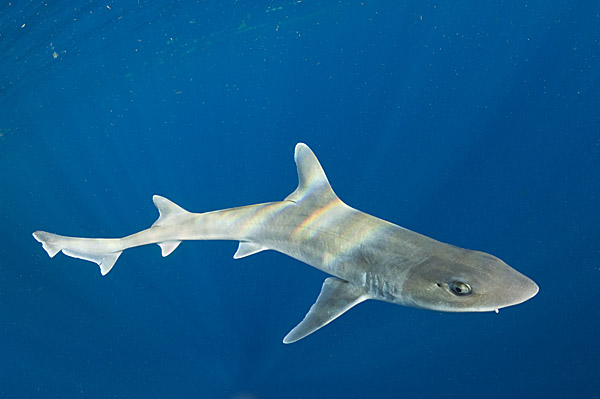
Spiny Dogfish

Both the smooth and spiny dogfish inhabit the waters off of New Jersey. Both of these sharks are small in size, reaching an average length of 3-4 feet. Larger dogfish have been seen though as long as 5 feet. Both of these species of shark have very small teeth and mainly eat small fish, shellfish, and crustaceans. Younger dogfish may also eat worms. The way to distinguish these two sharks is simple. The smooth dogfish has no spots and lacks spines on their dorsal fins while the spiny dogfish has white spots and spines on their dorsal fins. These animals are often viewed as pests by fishermen and many are killed for simply stealing a piece of bait intended for another fish. As a result of overfishing, both of these sharks are threatened with extinction. The smooth dogfish is currently listed as "Near Threatened" on the IUCN's Red List while the spiny dogfish is listed as "Vulnerable".
Basking Shark

One look at this shark and people start to panic. Afterall, what you are looking at is the second largest shark in the entire world. This shark can grow to be roughly 26 feet in length and can take in 1,800 tons of water per hour. Why would it do that you ask? Well this big guy is a filter feeder! You read that right! This species of shark simply eats plankton, small fish, krill, etc. They simply swim with their mouths open and filter the water out! Unlike the other sharks I've mentioned so far, the basking shark tends to stay more offshore, but on occasion they do move in closer if food is around. They are also mainly surface feeders so if you are out on a boat keep an eye out for one or a whole school! Be warned though, they are not too common in our area so if you do see one be sure to enjoy every moment of it! The basking shark is currently listed as "Vulnerable" on the IUCN's Red List. The primary threats these animals face is finning, overfishing, and boat strikes due to surface feeding and careless boat operators.
Blue Shark
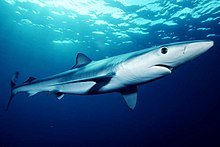
The blue shark is a speedy shark that is normally found off shore of New Jersey. This species of shark is highly migratory and have been known to cross the Atlantic many times throughout the course of their lives. Unlike most species of shark, the blue shark can give birth to more than 20 pups! They average out at about 6 to 9 feet in length and mostly eat squids, but have also been seen eating birds and even small dolphins and other mammals. Occasionally these sharks do come very close to shore as one was seen in the surf in New Jersey just a few ago surfing through the waves. As with all the other sharks listed thus far, the blue shark has never bitten anyone in the waters off New Jersey. Despite a higher reproductive rate, the blue shark is still being threatened with extinction and is currently listed as "Near Threatened" on the IUCN's Red List. This listing again is a result of overfishing and finning.
Nurse Shark
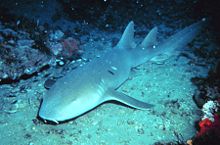
The nurse shark is a very docile species of large shark that occasionally visits New Jersey. Just a few years ago, a large nurse shark was seen resting inside the Manasquan Inlet. These sharks are huge shellfish and crustacean eaters and have flat teeth to aid in the crushing of those tough shells. Nurse sharks can grow to be a whopping 14 feet in length! Not much else to really say about this shark. They are a very peaceful species of shark and spend a lot of their time simply resting on the bottom of the ocean either sleeping or waiting for an unsuspecting crab to walk too close. The nurse shark is currently listed as "Data Deficient" on the IUCN's Red List. They are not regularly hunted, but due to the fact that they are so docile and are slow swimmers, it makes them easy targets for local fisheries that use their skin in the production of leather products.
Atlantic Angel Shark
This is a new one to me. Until recently I had no idea these sharks actually could be found off of New Jersey. This species of shark can be found offshore and tends to mostly stay on the bottom. They can grow to be 5 feet in length and are known to prey on fish, crustaceans, and small rays. They rarely come in contact with people and as a result are currently listed as "Data Deficient" on the IUCN's Red List. There is currently no commercial demand for this shark either, but it's meat is apparently edible (and high in mercury).
Porbeagle
No that is not a great white you see in the above picture! That is it's "little" cousin, the porbeagle! This large species of shark can grow to be 8 feet in length. The porbeagle typically inhabits the waters offshore of New Jersey, but as with other sharks, it has been known to occasionally venture close to shore. The primary diet of this shark includes bony fishes and squid. Much like it's bigger cousin, the porbeagle is warm blooded and does quite well in cooler waters. As with the other large sharks on the list, this species of shark has never bitten anyone off the coast of New Jersey. This species has however experienced extreme commercial pressures and as a result is listed globally as "Vulnerable" on the IUCN's Red List. It is also listed as "Endangered" in the western north Atlantic and as "Critically Endangered" in the eastern north Atlantic and Mediterranean Sea. In March of 2013, this species of shark was listed on CITES Appendix II which allows for more regulations in the international trade of this shark.
Okay so we are 8 sharks in already. I'm sure some of the names you have seen so far may be familiar to you... or not... Either way, there are still several more to go so you may want to grab a snack or a drink cause from here on in we will be looking at some of the more famous sharks that visit New Jersey!
Tiger Shark

If you have followed this blog for any length of time, you would most certainly have seen me talking about tiger sharks. Yes, the same species of shark that was mercilessly hunted down in West Australia also inhabits the waters off of New Jersey during the summer months. This species of shark is large and many people consider it to be one of the more dangerous species of shark in the world. The average length of this shark is somewhere between 9 and 13 feet in length. Larger sharks can be over 15 feet! The primary diet of this shark is very extensive and includes both small and large fish, turtles, birds, dolphins, smaller sharks, and even dogs and horses (those last two are mostly reported in Hawaii so I guess you could say that it is not really a primary food source). I have heard a few occasions where scuba divers claim to have seen this shark just outside of the Manasquan Inlet. Despite being a fierce predator, tiger sharks have not bitten anyone off the beaches of New Jersey. The tiger shark is currently listed as "Near Threatened" on the IUCN's Red List.
Sand Tiger Shark
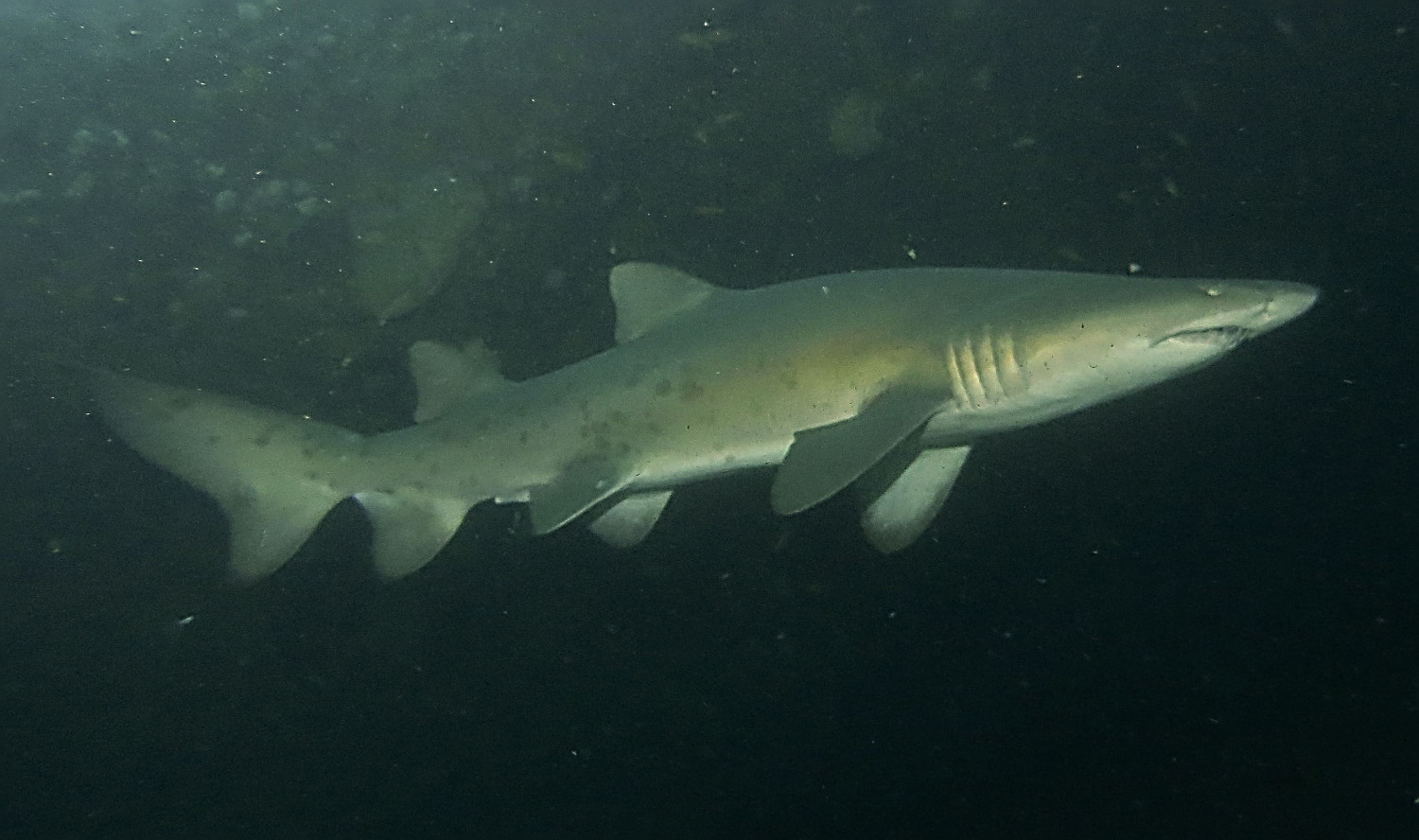
Probably the most common species of large shark that can be found off the coast of New Jersey. The sand tiger shark is a very common shark to see at aquariums around the world and anyone who has seen one can never forget the look of those dagger like teeth hanging from their mouths. Well let's just say those teeth are largely just for show. The sand tiger shark can grow to be 9 feet in length, but the average is more in the range of 7-8 feet. The primary diet of these sharks consists of bony fish of varying sizes as well as rays, skates, and small sharks. They are very slow swimmers, but can produce massive bursts of speed when they feel threatened. They are also capable of a very quick horizontal bite. Divers often come in contact with these sharks and the sharks generally mind their own business unless being harassed. In New Jersey, the sand tiger shark has never bitten a human and divers typically respect the shark and get the same respect back in return. The sand tiger shark is currently listed as "Vulnerable" on the IUCN's Red List. This species of shark is Illegal to catch off the coast of New Jersey. If caught, it must be released!
Scalloped Hammerhead

Smooth Hammerhead
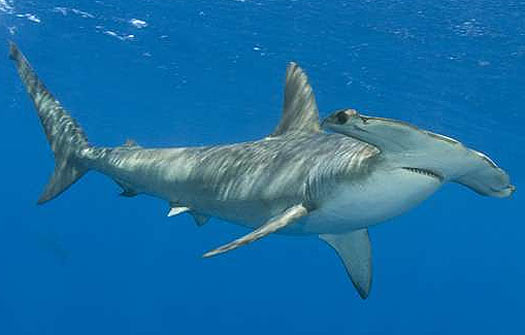
One look at the head of these sharks and people are usually filled with amazement. No wonder why... The head of these sharks are literally shaped like a hammer. All hammer jokes aside, these species of shark are an uncommon, yet amazing visitor to New Jersey during the summer months. Scalloped hammerheads grow to be anywhere between 6 and 8 feet in length while the smooth hammerhead can grow to be a massive 16 feet in length. The primary diet of these sharks include bony fish and occasionally squid and octopus. Larger sharks may also prey on smaller sharks such as the dogfish noted above. The smooth hammerhead has been seen in the Indian River, Fla. (a freshwater river) as well as Nova Scotia. The scalloped hammerhead has been seen in massive schools while migrating or hunting. Despite their sizes, the scalloped and smooth hammerheads tend to shy away from humans unless provoked and have never bitten anyone in New Jersey waters. Both of these sharks however are prime catches for the shark fin trade and as a result the scalloped hammerhead has been listed as "Endangered" on the IUCN's Red List and the smooth hammerhead has been listed as "Vulnerable".
Great White Shark

Well here he is. The shark that I believe most people did not expect or want to see on this list. Yes ladies and gentlemen, boys and girls, the great white shark does visit New Jersey each and every year. Though around here it does tend to stay offshore (as seen in a video shot last year off the coast) they do venture in close to shore as well. This shark (the big cousin of the porbeagle) can grow to be roughly 21 feet in length. The primary diet of this shark is quite wide and consists of marine mammals, fish, other sharks, and birds. The behavior of this shark does vary from place to place as in Australia and South Africa they can be seen ambushing prey from beneath. Off the east coast of the United States they are known to chase prey as opposed to ambush them, sometimes going over shallow sandbars in an attempt to slow down seals and other marine mammals. While great whites biting people is a well known thing, in New Jersey there is debate about whether or not the great white is responsible in the 1916 shark attacks which saw 4 people killed and 1 badly injured in a span of 12 days along the coast and in the Matawan creek. Other than those potential incidents, the great white shark has not bitten anyone off of New Jersey. This shark also was the famous evil in the movie Jaws which turned many, many people against this shark. Since then great whites have been regularly hunted and killed for nothing more than fear of them being "man eaters" when in reality the vast majority of the times white sharks have bitten someone, the person has survived. Many scientists now believe that this species of shark often mistakenly identifies humans as a food source as they seem to reject the human after an exploratory bite. Due to overfishing and finning, this species populations have plummeted and this shark is now listed as "Vulnerable" on the IUCN's Red List. It is also listed on CITES Appendix II. Some scientists now believe there are more tigers than great white sharks left on Earth.
Thresher Shark

The thresher shark is another large species of shark that visits New Jersey during the summer months. This species of shark can grow to be 20 feet in length, but nearly half of that length will be it's tail. The primary diet of the thresher shark consists of bony fishes that it will first strike at, not with it's mouth, but it's tail. There have been many stories about thresher sharks and many are unconfirmed such as the following... One story tells of a thresher smacking a bird out of mid air and then eating it. Another story, which is actually very believable includes a thresher smacking a fish out of the water and catching it with it's mouth. The most disputed story though is that of a fisherman who had snagged a thresher on a long line. When he went to see what was on the line, the tail of the shark cut the man's head off and the head was never recovered. Most do not buy into that story as the thresher's tail, while strong, is nowhere near rigid enough to do that kind of damage. In general these sharks are harmless towards people and there is only one incident of a thresher acting aggressive towards a human (not counting those trying to resist being caught). In New Jersey there has been 0 incidents of threshers showing aggression. In general these sharks stay offshore, but do occasionally come inshore as well. Due to both recreational and commercial pressures, the thresher shark is currently listed as "Vulnerable" on the IUCN's Red List.
Shortfin Mako Shark

The fastest shark in the sea! The shortfin mako is a common large species of shark in the offshore waters of New Jersey. They rarely venture close to shore and are usually seen chasing down their prey at speeds of around 60mph! This species of shark can grow to be 10 feet in length and are known to leap over 10 feet into the air! The primary diet of this shark includes bony fishes, squid and occasionally birds, turtles, other sharks, and small marine mammals. In New Jersey, this shark is highly sought after by recreational fishermen and as a result their populations have dropped by an estimated 50% in the area. Still shark kill tournaments continue for both this shark and the thresher out of New Jersey. In New Jersey, this shark is responsible for 0 bites on humans (again not counting fishermen who are trying to catch them). As with it's cousin, the great white, this shark is currently listed on the IUCN's Red List as "Vulnerable". This listed comes as a result of both finning operations as well as a commercial demand for it's meat (which is very high in mercury and the FDA warns that men, women, and children should all avoid eating).
Whale Shark

I'd wager that not many people expected to see this face in this blog. Yes, the whale shark, the largest fish in the entire ocean visits New Jersey! However, it is very rare that it does as New Jersey is located at the northern tip of their range. Still, just 2 years ago one was seen and nearly ran into by a boat off the coast of Atlantic City. Much like the basking shark, the whale shark is a filter feeder meaning they are not going to be eating any kind of marine mammal or large bony fish. Instead they feed largely on plankton and krill that they happen to filter through their 4 foot wide mouth. Whale sharks can grow to be over 40 feet in length and are known to commonly feed at the surface. The whale shark has never shown any aggression towards humans, but have been known to bump into boats and try to steal small fish out of nets from time to time. They are mostly found offshore, but do occasionally come in close to shore in search of food. Again, they are very rare to see in New Jersey, but if you are out on a boat, keep your eyes peeled for a spotted fin lazily gliding across the water. There's a good chance you could be stumbling upon the largest fish in the world! The whale shark is currently listed as "Vulnerable" on the IUCN's Red List due to overfishing and finning.
Bull Shark

Another shark that a lot of people probably did not want to see on this list. The bull shark is a large, aggressive species of shark that can be found mostly in shallow waters. They are a unique shark in that they are capable of surviving in both salt and fresh water. In fact a bull shark had once been spotted near Saint Lois, literally hundreds of miles inland from the ocean. The average length of this shark is roughly 8 feet, but bull sharks larger than 11 feet have been recorded. The primary diet of this shark includes bony fish, other sharks (including other bull sharks), turtles, terrestrial animals, birds, dolphins, rays, echinoderms, and crustaceans. This shark is often thought of as the shark responsible for the 1916 New Jersey shark attacks that claimed the lives of 4 people in the span of 12 days. There is a lot of debate however as to whether or not this shark or the great white was responsible for those incidents. The bull shark is not a common shark to see in New Jersey, and outside of the 1916 incidents (which is to this day in debate and a mystery), the bull shark has not been recorded in biting anyone in the waters off or within New Jersey. The bull shark is listed as "Near Threatened" on the IUCN's Red List.
So here we are at the end of this blog. I hope you all learned a little something you may not have known about the sharks that visit New Jersey. Before you enter the water, just be aware of whose territory you are entering. The ocean is not man's domain, it is the domain of the shark and they are the rulers of that domain as much as humans try to see to it otherwise. Should you come in contact with them, respect them and you will receive the same respect in return. Not a single one of these sharks are out to get you. If they were, sharks would be one of the most dangerous animals on the planet. As it stands they are not. In fact, the little dogs and cats that we as humans love so much are far more dangerous. The hippos and cows that we love to look at and think are so cute are far more dangerous. Even elephants are responsible for more deaths every year than sharks. So please, do not fear these animals. Know who they are and what they do and you will easily be able to avoid being bitten and if you'd rather, avoid them completely. I've been swimming in the waters off New Jersey for over 20 years and not once have I come in contact with these animals while in the water. I've seen sandbar sharks feeding from land. I've seen videos of a great white off of New Jersey investigating a boat with no intent on harming anything. I've even spoken to divers who've seen a large tiger shark, which did nothing to any of them. They are out there, but they just do not care that we are in their waters. They know you are not on their menu and as long as you do not provoke or harass them, they will leave you alone.
Also I want you to take a look back at the list really quickly. Each and every one of these sharks (with the exception of the nurse and Atlantic angel shark) are threatened or are near becoming threatened with extinction. The IUCN lists these animals based on their population trends and other factors. Near Threatened is for animals that are dangerously close to becoming threatened with extinction. Vulnerable is given to animals that will most likely become endangered in the near future. We all should know what a listing of Endangered and Critically Endangered should mean. So needless to say, the time to save these animals is now. Shark finning and overfishing are very, very real problems that our world is having to deal with right now. Even local shark tournaments featuring the killing of sharks are posing a problem for local populations of shark as made evident by the mako populations off of New Jersey. Just remember to keep all of this stuff in mind as you visit the New Jersey shore this summer! Enjoy the oceans and remember, you are entering into their world. They are not entering yours!